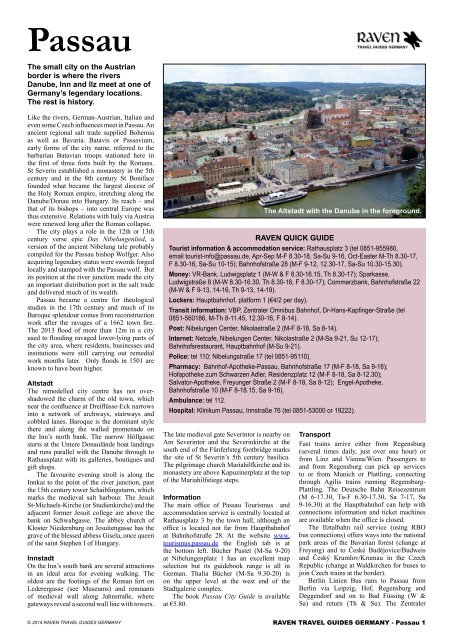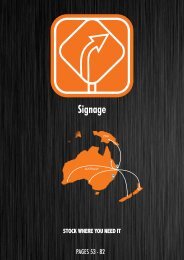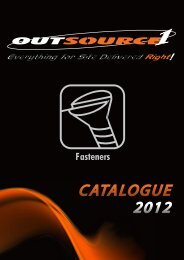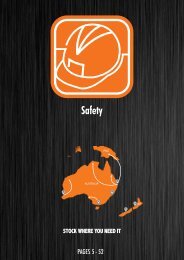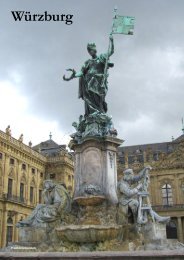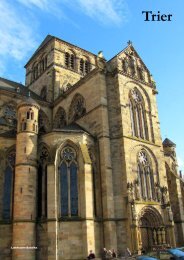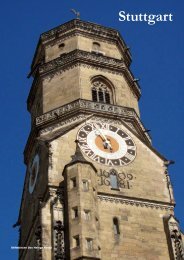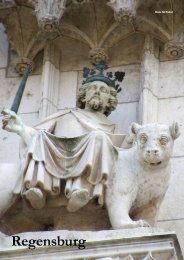Raven Guides: Germany - Passau
You also want an ePaper? Increase the reach of your titles
YUMPU automatically turns print PDFs into web optimized ePapers that Google loves.
<strong>Passau</strong><br />
The small city on the Austrian<br />
border is where the rivers<br />
Danube, Inn and Ilz meet at one of<br />
<strong>Germany</strong>’s legendary locations.<br />
The rest is history.<br />
Like the rivers, German-Austrian, Italian and<br />
even some Czech influences meet in <strong>Passau</strong>. An<br />
ancient regional salt trade supplied Bohemia<br />
as well as Bavaria. Batavis or Passavium,<br />
early forms of the city name, referred to the<br />
barbarian Batavian troops stationed here in<br />
the first of three forts built by the Romans.<br />
St Severin established a monastery in the 5th<br />
century and in the 8th century St Boniface<br />
founded what became the largest diocese of<br />
the Holy Roman empire, stretching along the<br />
Danube/Donau into Hungary. Its reach – and<br />
that of its bishops – into central Europe was<br />
thus extensive. Relations with Italy via Austria<br />
were renewed long after the Roman collapse.<br />
The city plays a role in the 12th or 13th<br />
century verse epic Das Nibelungenlied, a<br />
version of the ancient Nibelung tale probably<br />
compiled for the <strong>Passau</strong> bishop Wolfger. Also<br />
acquiring legendary status were swords forged<br />
locally and stamped with the <strong>Passau</strong> wolf. But<br />
its position at the river junction made the city<br />
an important distribution port in the salt trade<br />
and delivered much of its wealth.<br />
<strong>Passau</strong> became a centre for theological<br />
studies in the 17th century and much of its<br />
Baroque splendour comes from reconstruction<br />
work after the ravages of a 1662 town fire.<br />
The 2013 flood of more than 12m in a city<br />
used to flooding ravaged lower-lying parts of<br />
the city area, where residents, businesses and<br />
institutions were still carrying out remedial<br />
work months later. Only floods in 1501 are<br />
known to have been higher.<br />
Altstadt<br />
The remodelled city centre has not overshadowed<br />
the charm of the old town, which<br />
near the confluence at Dreiflüsse-Eck narrows<br />
into a network of archways, stairways and<br />
cobbled lanes. Baroque is the dominant style<br />
there and along the walled promenade on<br />
the Inn’s north bank. The narrow Höllgasse<br />
starts at the Untere Donaulände boat landings<br />
and runs parallel with the Danube through to<br />
Rathausplatz with its galleries, boutiques and<br />
gift shops.<br />
The favourite evening stroll is along the<br />
Innkai to the point of the river junction, past<br />
the 15th century tower Schaiblingsturm, which<br />
marks the medieval salt harbour. The Jesuit<br />
St-Michaels-Kirche (or Studienkirche) and the<br />
adjacent former Jesuit college are above the<br />
bank on Schwabgasse. The abbey church of<br />
Kloster Niedernburg on Jesuitengasse has the<br />
grave of the blessed abbess Gisela, once queen<br />
of the saint Stephen I of Hungary.<br />
Innstadt<br />
On the Inn’s south bank are several attractions<br />
in an ideal area for evening walking. The<br />
oldest are the footings of the Roman fort on<br />
Lederergasse (see Museums) and remnants<br />
of medieval wall along Jahnstraße, where<br />
gateways reveal a second wall line with towers.<br />
The late medieval gate Severintor is nearby on<br />
Am Severintor and the Severinkirche at the<br />
south end of the Fünferlsteg footbridge marks<br />
the site of St Severin’s 5th century basilica.<br />
The pilgrimage church Mariahilfkirche and its<br />
monastery are above Kapuzinerplatz at the top<br />
of the Mariahilfstiege steps.<br />
Information<br />
The main office of <strong>Passau</strong> Tourismus and<br />
accommodation service is centrally located at<br />
Rathausplatz 3 by the town hall, although an<br />
office is located not far from Hauptbahnhof<br />
at Bahnhofstraße 28. At the website www.<br />
tourismus.passau.de the English tab is at<br />
the bottom left. Bücher Pustet (M-Sa 9-20)<br />
at Nibelungenplatz 1 has an excellent map<br />
selection but its guidebook range is all in<br />
German. Thalia Bücher (M-Sa 9.30-20) is<br />
on the upper level at the west end of the<br />
Stadtgalerie complex.<br />
The book <strong>Passau</strong> City Guide is available<br />
at €5.80.<br />
RAVEN QUICK GUIDE<br />
Tourist information & accommodation service: Rathausplatz 3 (tel 0851-955980,<br />
email tourist-info@passau.de, Apr-Sep M-F 8.30-18, Sa-Su 9-16, Oct-Easter M-Th 8.30-17,<br />
F 8.30-16, Sa-Su 10-15); Bahnhofstraße 28 (M-F 9-12, 12.30-17, Sa-Su 10.30-15.30).<br />
Money: VR-Bank, Ludwigsplatz 1 (M-W & F 8.30-16.15, Th 8.30-17); Sparkasse,<br />
Ludwigstraße 8 (M-W 8.30-16.30, Th 8.30-18, F 8.30-17); Commerzbank, Bahnhofstraße 22<br />
(M-W & F 9-13, 14-16, Th 9-13, 14-19).<br />
Lockers: Hauptbahnhof, platform 1 (€4/2 per day).<br />
Transit information: VBP, Zentraler Omnibus Bahnhof, Dr-Hans-Kapfinger-Straße (tel<br />
0851-560186, M-Th 8-11.45, 12.30-16, F 8-14).<br />
Post: Nibelungen Center, Nikolastraße 2 (M-F 8-18, Sa 8-14).<br />
Internet: Netcafe, Nibelungen Center, Nikolastraße 2 (M-Sa 9-21, Su 12-17);<br />
Bahnhofsrestaurant, Hauptbahnhof (M-Su 9-21).<br />
Police: tel 110; Nibelungstraße 17 (tel 0851-95110).<br />
Pharmacy: Bahnhof-Apotheke-<strong>Passau</strong>, Bahnhofstraße 17 (M-F 8-18, Sa 9-18);<br />
Hofapotheke zum Schwarzen Adler, Residenzplatz 12 (M-F 8-18, Sa 8-12.30);<br />
Salvator-Apotheke, Freyunger Straße 2 (M-F 8-18, Sa 8-12); Engel-Apotheke,<br />
Bahnhofstraße 10 (M-F 8-18.15, Sa 9-16).<br />
Ambulance: tel 112.<br />
The Altstadt with the Danube in the foreground.<br />
Hospital: Klinikum <strong>Passau</strong>, Innstraße 76 (tel 0851-53000 or 19222).<br />
Transport<br />
Fast trains arrive either from Regensburg<br />
(several times daily, just over one hour) or<br />
from Linz and Vienna/Wien. Passengers to<br />
and from Regensburg can pick up services<br />
to or from Munich or Plattling, connecting<br />
through Agilis trains running Regensburg-<br />
Plattling. The Deutsche Bahn Reisezentrum<br />
(M 6-17.30, Tu-F 6.30-17.30, Sa 7-17, Su<br />
9-16.30) at the Hauptbahnhof can help with<br />
connections information and ticket machines<br />
are available when the office is closed.<br />
The Ilztalbahn rail service (using RBO<br />
bus connections) offers ways into the national<br />
park areas of the Bavarian forest (change at<br />
Freyung) and to České Budějovice/Budweis<br />
and Český Krumlov/Krumau in the Czech<br />
Republic (change at Waldkirchen for buses to<br />
join Czech trains at the border).<br />
Berlin Linien Bus runs to <strong>Passau</strong> from<br />
Berlin via Leipzig, Hof, Regensburg and<br />
Deggendorf and on to Bad Füssing (W &<br />
Sa) and return (Th & Su). The Zentraler<br />
© 2014 RAVEN TRAVEL GUIDES GERMANY<br />
RAVEN TRAVEL GUIDES GERMANY - <strong>Passau</strong> 1


